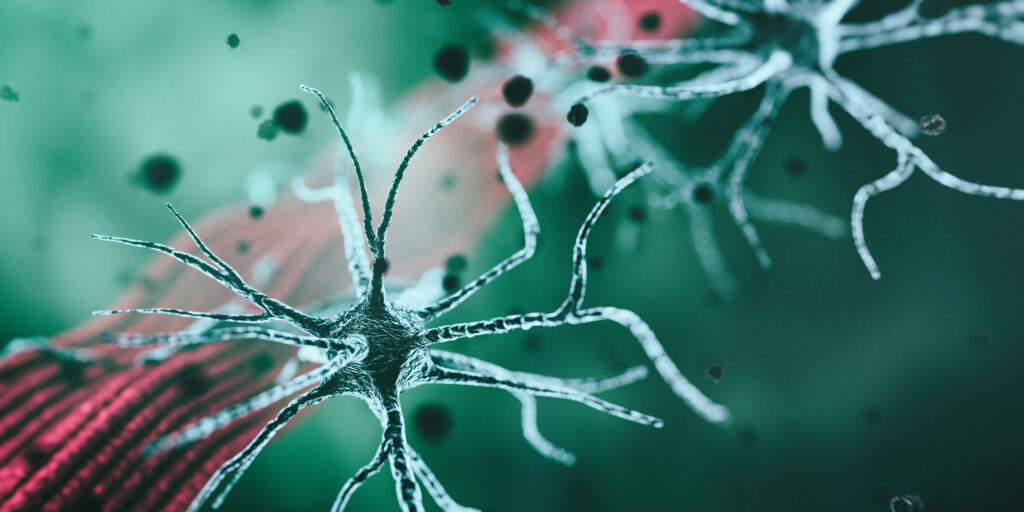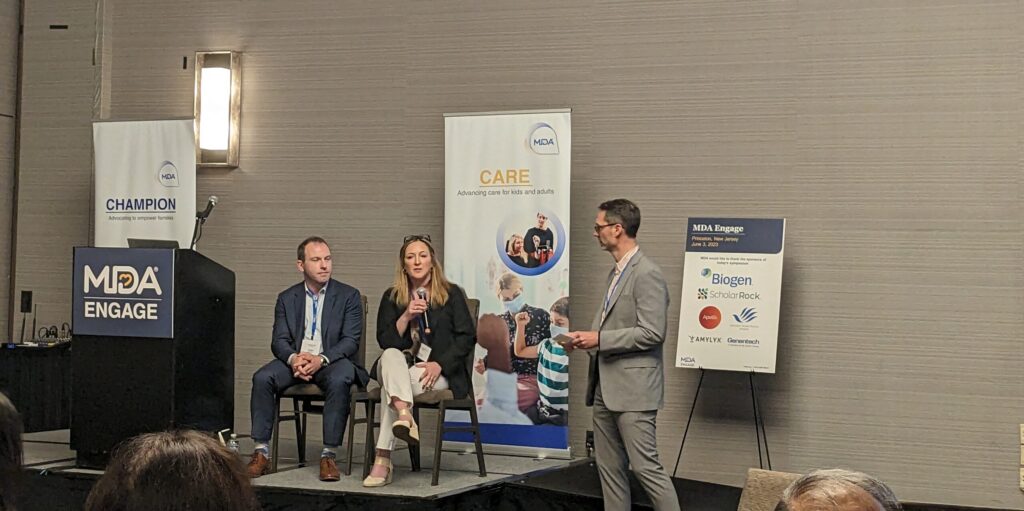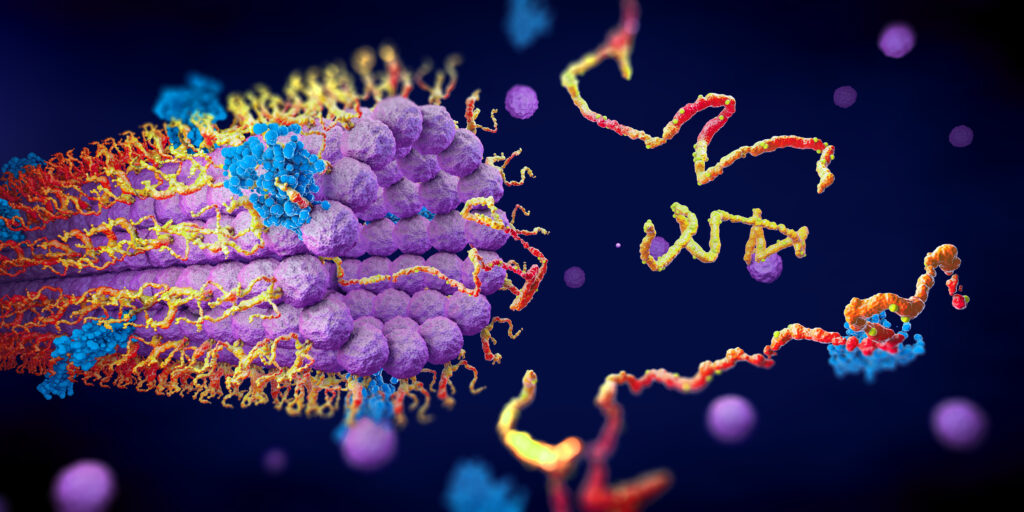
Simply Stated: Research Updates in Facioscapulohumeral Muscular Dystrophy (FSHD)
By Sujatha Gurunathan | Tuesday, February 28, 2023
5 Second Summary
“Simply Stated” is a Quest column designed to explain some terms and basic facts about neuromuscular diseases.
Find more at Mdaquest.org/tag/simply-stated
Facioscapulohumeral muscular dystrophy (FSHD) is a rare genetic disorder that affects the muscles of the face (facio), shoulders (scapulo), and upper arms (humeral). It is one of the most common forms of muscular dystrophy, with its prevalence estimated to be between 1 in 8,000 and 1 in 20,000 individuals worldwide.
Symptoms of FSHD
Most people with FSHD begin experiencing symptoms by their 20s, although disease onset can occur anytime from infancy to middle age. Progression of FSHD is typically slow, but the symptoms, severity, and progression of disease can vary greatly between different people. In general, FSHD causes gradual muscle weakness that starts in the face, shoulders and upper arms before moving to other muscles. This weakness is often asymmetric, meaning that it occurs more on one side of the body than the other. People with FSHD who develop symptoms at an early age tend to experience more severe disease, sometimes leading to dependence on a wheelchair. In most cases, the disease is not life-threatening and does not significantly affect life span.
Cause of FSHD
Most researchers believe that FSHD is caused by shortening of the DNA in a region of chromosome 4 that contains many repeats of a particular DNA sequence, known as “D4Z4 repeats,” which each include a copy of the DUX4 gene. The shortening of the D4Z4 region, combined with the inheritance of a particular genetic variation (4qA allele) found in some people, leads to inappropriate expression of the DUX4 gene, which is normally expressed only during early development of the embryo and is turned off in adult tissues. In FSHD, however, the DUX4 gene is reactivated, creating a toxic environment in muscles that causes cell death and progressive weakness and atrophy (loss) of the muscles in the face, shoulders, and upper arms.
There are two genetically distinct types of FSHD. About 95% of people with the disease have FSHD type 1, which is associated with shortening of the D4Z4 region. FSHD type 2 is much less common and is caused by loss-of-function mutations in genes that normally prevent DUX4 expression.
The genetic change that causes FSHD is inherited in an autosomal dominant pattern, which means that a person needs to inherit only one copy of the disease-causing change in chromosome 4 from one parent to develop the condition. In some cases, however, FSHD can occur spontaneously, without any known family history.
For more information about the signs and symptoms of FSHD, as well an explanation of the genetic underpinnings of the disease, an in-depth overview can be found here.
Diagnosis of FSHD
FSHD can be difficult to diagnose; the symptoms can be variable and may be mistaken for other neuromuscular conditions. An FSHD diagnosis is typically based on a combination of clinical symptoms and genetic testing. A specialized genetic test performed in a diagnostic laboratory is required to detect shortening of the D4Z4 repeats and this test is often a prerequisite for enrollment in clinical trials. Genetic counseling and testing are important for individuals with a family history of FSHD or for those who are at risk of passing the condition on to their children.
Current management of FSHD
There is currently no known cure or disease-modifying therapy for FSHD. However, several therapies and strategies are available that can help manage the symptoms and improve the overall health of people with FSHD. These include:
- Physical therapy to improve muscle strength and mobility, reduce pain and stiffness, and prevent joint contractures
- Occupational therapy to help develop skills and strategies to carry out daily activities with greater independence, such as dressing, eating, and personal hygiene
- Medications, such as corticosteroids, to help manage symptoms such as inflammation and pain
- Surgery to correct joint contractures (muscle shortening) or address other issues
- Assistive devices, such as braces, splints, and orthotics to help support weak muscles and improve mobility
- Exercise, such as aerobic and resistance training, to improve muscle strength, mobility, and overall health
Given the variability of disease progression and symptoms experienced by different people with FSHD, treatment plans are typically individualized to meet the needs of the affected person and may include recommendations from a variety of specialists.
Care recommendations to guide physicians in evidence-based diagnosis and treatment of people living with FSHD have been published by the European Neuro Muscular Centre (2010) and members of the American Academy of Neurology and the American Association of Neuromuscular & Electrodiagnostic Medicine (2015). Furthermore, the FSHD Society holds multiple conferences each year, known as FSHD 360 Conferences, to publicize the latest in research, condition management, and personal empowerment as a resource for people living with FSHD.
Evolving research and treatment landscape
While the standard of care is still symptom management, research advances and the promise of better therapeutics on the horizon offer hope for people living with FSHD. Understanding of the genetic elements that cause FSHD have led to improved diagnosis and are guiding the development of new treatment strategies.
The drug candidate that is closest to receiving US Food and Drug Administration (FDA) approval for treatment of FSHD is losmapimod, a small molecule that inhibits an enzyme known as p38MAPK, thereby reducing expression of the DUX4 gene. Long-term treatment with losmapimod (up to 96 weeks) was shown to slow or stop the loss of muscle function in people with FSHD, as assessed by the “reachable workspace” test that measures the ability of participants to achieve a range of arm motions. Losmapimod is currently in a phase 3 clinical trial (Reach) sponsored by Fulcrum Therapeutics.
In addition to treatment with small molecules, such as losmapimod, additional strategies are being tested to target DUX4 expression, or downstream signaling events that follow DUX4 expression, in FSHD. Some of these targeted strategies include:
- Antisense oligonucleotide (ASO) therapy: ASO therapy uses short strands of RNA to modify or block the expression of specific genes. Several ASO therapies are being developed to reduce the expression of the DUX4 gene in FSHD, though none have yet reached the clinical trial stage.
- Gene editing: Gene editing techniques, such as CRISPR/Cas9, are being explored in preclinical models as a way to make precise changes to the DNA sequence to correct the genetic changes that cause FSHD.
Non-targeted therapeutic strategies are also being explored to help preserve or restore muscle tissue in FSHD. These strategies include:
- Stem cell therapy: This approach aims to regenerate or replace damaged muscle cells using stem cells.
- Exercise and physical activity interventions: Researchers are testing different exercise regimens to find effective protocols to improve muscle strength and function.
- Anti-myostatin therapy: Use of antibodies to block myostatin, a protein that normally inhibits muscle growth, are being studied in a phase 2 clinical trial that is currently enrolling.
These various therapies are still in the early stages of development and may not be available for widespread use for some time. They represent promising areas of research, however, that could lead to new and effective treatments for FSHD.
Clinical trial readiness
In order to prepare for drug development in the FSHD field, some researchers are focusing on natural history studies to better understand the rate of disease progression and validate clinical outcome measures and biomarkers for use in future clinical trials. Clinical trial readiness is the goal of the Facioscapulohumeral Muscular Dystrophy Clinical Trial Research Network (FSHD CTRN), a consortium of fifteen academic research centers (12 in the United States and 3 in Europe) with expertise in conducting FSHD clinical research and trials. With the work being done to develop new therapies comes the need for the research community to prepare for clinical trials. Establishing and maintaining an FSHD CTRN allows researchers to:
- Create an infrastructure of trained clinical evaluators using standardized approaches to measuring progression in FSHD
- Develop regulatory strategies which are stream-lined to accelerate therapeutic development
- Ensure all major stakeholders have a say in the drug development process, including researchers, patients, patient advocates, and industry
- Create a nationwide recruitment strategy to ensure all people with FSHD are represented
- Train the next generation of FSHD researchers
- Run studies to build the tools for running high quality clinical trials, or testing new therapies
Through their combined efforts, the centers of the FSHD CTRN are working to enable efficient, high quality clinical trials for FSHD therapeutics.
To learn more about clinical trial and natural history study opportunities in FSHD, visit clinicaltrials.gov and search for “facioscapulohumeral muscular dystrophy” in the condition or disease field.
MDA’s work to further cutting-edge FSHD research
Since its inception, MDA has invested more than $26 million in FSHD research. Notably, MDA funded the development of two FSHD mouse models that link DUX4 expression to changes in skeletal muscle to model the human disease (Dr. Peter Jones and Dr. Scott Harper). More recently, MDA has supported a number of efforts to better understand the disease-causing processes that contribute to FSHD. Funded projects include:
Muscular Dystrophy Clinical Trial Research Network (2022-2025)
Dr. Jeffrey Statland, University of Kansas Medical Center Research Institute
The goal of this program is to expedite the development of new therapies and improve care for muscular dystrophies by developing a core Muscular Dystrophy Clinical Trial Research Network (MD CTRN) that encompasses the FSHD Clinical Trial Research Network (FSHD CTRN), Genetic Resolution and Assessments Solving Phenotypes in LGMD (GRASP LGMD), and the DM Clinical Research Network (DMCRN). Core sites include 15 academic centers geographically distributed across the United States, with 15 collaborating centers in the United Kingdom, Europe, and Canada.
Developing 2’MOE-based therapy for facioscapulohumeral muscular dystrophy (2019-2023)
Dr. Yi-Wen Chen, Children’s Research Institute (CNMC)
The goal of this study is to test modified antisense oligonucleotides (ASOs) (called 2’MOE gapmers) in preclinical animal models of FSHD to determine their effectiveness in reducing DUX4 expression in muscle tissues.
Pathogenesis and therapeutic targets in FSHD (2019-2022)
Dr. Jeffrey Miller, Boston University
This study is designed to identify pathogenic (disease-causing) mechanisms and possible therapeutic strategies for FSHD.
Biomarkers for FSH Muscular Dystrophy from Single Cell Expression Analyses (2018-2022)
Dr. Lawrence Hayward, University of Massachusetts Chan Medical School
In this study, researchers are profiling the gene expression patterns in thousands of individual cells from the muscle tissues of people with FSHD. This will help them understand the changes that happen at the cellular level in FSHD and may identify new targets for therapeutic intervention or new biomarkers for use in future clinical trials.
Drugs targeting DUX4 expression in FSHD (2018-2021)
Dr. Francis Sverdrup, Saint Lois University
The goal of this project is to identify drug targets to suppress DUX4 expression. The researchers are comparing various drug classes and studying the mechanisms of how each class affects DUX4 expression. This will be a critical step in advancing the best therapies towards clinical development.
Facioscapulohumeral Muscular Dystrophy Clinical Trial Research Network (FSHD CTRN)
Jeffrey Statland at University of Kansas Medical Center Research Institute
As previously mentioned, the overall goal of the FSHD CTRN is to expedite the development of new therapies for FSHD by developing and maintaining a core FSHD Clinical Trial Research Network.
Together, these studies and programs will help researchers identify new targets for therapeutic intervention and new biomarkers for use as reliable readouts for future clinical trials, thereby improving prospects for better disease management for people living with FSHD.
Next Steps and Useful Resources
- MDA’s Resource Center provides support, guidance, and resources for patients and families, including information about facioscapulohumeral muscular dystrophy, open clinical trials, and other services. Contact the MDA Resource Center at 1-833-ASK-MDA1 or ResourceCenter@mdausa.org.
- Stay up-to-date on Quest content! Subscribe to Quest Magazine and Newsletter.
TAGS: Healthcare, Research, Simply Stated
TYPE: Blog Post
Disclaimer: No content on this site should ever be used as a substitute for direct medical advice from your doctor or other qualified clinician.




